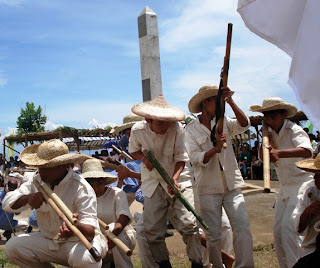 |
Teatro Balangaw group re-enacting the battle in 2007.
Up to the present, no study has been made on the origin
of “Pulang Lupa” as a place-name. Stories, however, are being told that it
refers to pulang lupa, red soil that could be found in the mountain range of
Kambindol, (apparently an older name of the same mountain range that could be traced to older maps). Other stories attribute the origin of Pulang Lupa to that bloody
battle that transpired there in 1900.
But where ‘there'? That a historical marker stands at the
site of that famous episode in local history, a site even listed as a National
Historical Landmark by the National Historical Institute, is not evidence. Not evidence
that the battle happened atop that rugged mountain which offers a great
panoramic view of the north-eastern and south-eastern sections of Marinduque.
All accounts of the battle (and there are numerous accounts now available from
primary sources) contradict that repeated claim, as well as books with stories
of that battle written by some of the world’s foremost historians.
‘Pulang Lupa’ as a place-name does not appear in eyewitness reports,
soldier’s diaries, nor in U.S. military records relating to that war, nor in
newspaper articles published in the U.S. during that period. The name appears, however, in a very brief account of the battle written by local historian, Ramon Madrigal, in 1963.
|
 |
| www.ulongbeach.com Battle of Pulang Lupa Page
A highly informative website that contains significant literature, first-hand accounts and photos of the American engagement in Marinduque available in U.S. libraries, that have been researched and compiled by a
Marinduque history and culture enthusiast, Curt Shepard and his Filipina wife Dalia, could be found on www.ulongbeach.com.
This will prove invaluable to historical researchers and may prompt a desire to know more.
|
 |
In an earlier post entitled ‘Pulang Lupa: Scanning Masaguisi
this time’ (Sept. 11, 2010), I pointed out a location mentioned in primary sources that could not be the ‘battle
site’ as we have been made to believe all these years. A place where, as described by Capt. Shields, he
fell seriously wounded. This was a rice field near Masaguisi (written by the
Americans as Massiquisie), where renewed enemy fire forced the Americans to take
cover behind paddy dikes. Read
By his own account, Shields and his companions had to march
in a brook and run over an extremely rocky bed. Then he took a direction that
led to Masaguisi. There he was again wounded with the bullet passing through
his neck and mouth, falling partly in a small stream until he was lifted out of
the water. Carried by his men about two hundred yards farther until they were
captured by the local forces. Some of his men were even captured in a swamp near the
seashore.
|
 |
To the point, here now comes a new publication, The Encyclopedia of the Spanish- American and Philippine-American Wars: A Political, Social, and Military History – Spencer C. Tucker ABC-CLIO. 2009. It
is a book that covers the conflict between the U.S. and Spain and with the Philippines “with a depth and
breadth no other reference work can match”.
BATTLE OF MASSIQUISIE
Event Date: September
13, 1900
Excerpts:
"In early September,
the presence of the U.S. Navy (ex-Spanish) gunboat Villalobos gave Shields the
opportunity to deploy his forces in Torrijos, located on Marinduque’s
southeastern coast. Ordering First Lieutenant M.H. Wilson and 41 soldiers by
water to land on September 11 near Torrijos. There the Americans scattered a
group of 20 guerillas and demolished their compound.
"On September 13,
Shields and his troops marched into the interior, intending to return to Santa
Cruz. Abad then massed virtually his entire insurgent force of some 250 men
with rifles and another 2,000 with bolos beside a vertical height overlooking
the path. Shields led his detachment right into the trap. Following several
hours of fighting, he ordered a withdrawal into a concealed gorge. But this
soon became a dash through a rock-strewn stream as he and his men struggled to
flee the insurgent flanking columns that were attempting a double envelopment.
After withdrawing for more than 3 miles, the harassed Americans took cover in a
rice paddy close to the town of Massiquisie; guerilla rifle fire compelled them
to seek shelter behind paddy dikes. Shields was among the wounded.
"With no other
recourse, Shields surrendered his entire force. Four Americans died in the
action, and all others were taken prisoners, 6 of them wounded. The Americans
estimated that 30 insurgents had perished in the fight, but this figure was
never verified. Following months of stealth, in less than a day of fighting
Abad had eliminated a third of the U.S. force on Marinduque.
"The Battle of Massiquisie prompted sharp reprisals from the
Americans, who reinforced their garrison on the island and launched a number of
stronger punitive raids, which did little to cripple guerilla activities." - RODNEY J. ROSS
|

.jpg)
